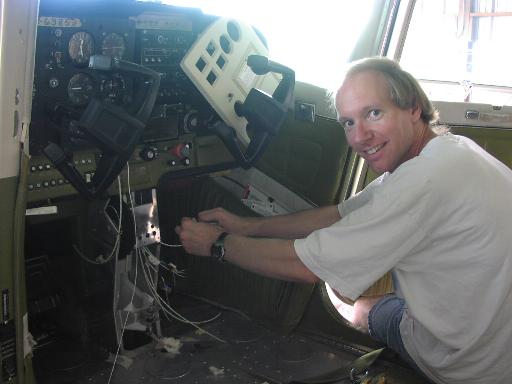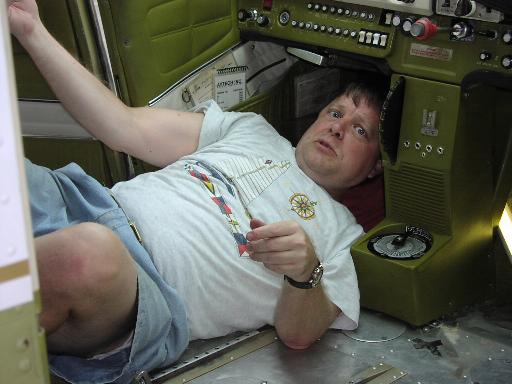 |
St. Louis Flying Club Newsletter - 22 September 2002 |
 From The President - By Mike Piccirilli
From The President - By Mike Piccirilli
Dear Members,
The plane has been undergoing some upgrades, over the past month, in a hangar at St. Charles County. John, Marlin, and Randy have been working on the intercom installation, and though alot more effort than planned, it's working great! The FAA has approved the field installation and we received the sign-off by the IA inspector from C&D Aviation. There are now headset hookups at all 4 positions with separate volume controls. John reports that communications are crystal clear. The squelch was also adjusted to remove the hiss. Thanks John, Marlin and Randy!
There has been debate about whether to install the new radio yet or wait for the cooling fan to be installed. Because of the way the radio stack is built, there is no easy way to pump cooling air to the radios. I get the feeling from John and Randy that installing the cooling fan is going to be a large hassle and might have marginal gain. Based on these comments, I suggest we return the cooling fan, install the new radio, and send the existing #1 radio back in for repairs. When it returns, we can then have 2 digital radios and monitor their performance against one another. Please let me know your thoughts on this question.
While the intercom was being installed, I took out the headliner, I had the old material removed, and then had the plastic headliner cracks repaired, painted it to match the existing interior plastic pieces and installed it. I think it looks pretty good! This will last indefinitely and we won't have to worry about the material deteriorating in the future. The cost was around $200. The headliner comes in 2 major pieces with another small piece that covers the seam. This small piece was cracked and disfigured. I ordered a new one and will be installing it in the next week or two (I have to trim it to fit and paint it to match (it cost $60).
Based upon the treasury position, I will make a determination on the timing of the remaining interior items. Based on all the work required, it probably makes sense to do while the airplane is torn apart for the annual. I will communicate the plan/options in a future newsletter. Painting work has not yet been done. I believe the issue is that one of the members must be present while the work is being done (per FARs). Coordinating this is a hassle. Perhaps this would be best done during the annual also. I'll let Randy make the call.
Happy Landings!
Pic
![]()
 Treasurer's Report - by Marlin Sipe
Treasurer's Report - by Marlin Sipe
Even with the expenses for the headliner and misc other things, the treasury still increased about $8, because of all the flying in the previous month. It's holding steady at about $735, which isn't bad considering we should have about $375 saved for the Annual right now.
Fuel at Smartt is only about $2.25, or about $.50 per gallon cheaper than at Spirit. If you happen to be going there anyway, consider topping it off while you're at Smartt. I did this when we were there for the intercom, putting in about 34 gallons (a $17 savings), and then again after that putting in about 19 gallons ($9.50 savings). Keep your eyes open when you go somewhere else too.
![]()
 Maintenance - by John Heilmann & Marlin Sipe
Maintenance - by John Heilmann & Marlin Sipe
Maintenance Actions - The following maintenance actions were completed over the past few weeks:
- Installed PM1000II Intercom, Co-Pilot PTT Switch and four sets of Headset jacks
- Removed and replaced vacuum system filter
- Changed oil and filter
- Installed repaired headliner. The remaining center trim piece will be installed shortly.
INTERCOM OPERATING INSTRUCTIONS
The intercom receives power when the avionics switch is on, just like the rest of the radios. There is a new 1 amp breaker next to the intercom, which protects just the intercom.
The left knobs are power, intercom volume and squelch for the pilot
The right knobs are intercom volume and squelch for the co-pilot and passengers.
 The switch in the center allows the pilot to be isolated. In the "ALL" position, everyone can talk to everyone else and everyone hears the a/c radio. In the up "ISO" position, the pilot can use the radio, but does not hear the co-pilot or passengers. Co-pilot and passengers can talk to each other without hearing the pilot or a/c radio. The down unmarked position is for a feature that our model does not have.
The switch in the center allows the pilot to be isolated. In the "ALL" position, everyone can talk to everyone else and everyone hears the a/c radio. In the up "ISO" position, the pilot can use the radio, but does not hear the co-pilot or passengers. Co-pilot and passengers can talk to each other without hearing the pilot or a/c radio. The down unmarked position is for a feature that our model does not have.
There is a new PTT switch on the co-pilot yoke, so that the co-pilot/instructor can handle the radio. Only the side pushing his PTT switch is heard on the radio. I believe that the co-pilot PTT will override the pilot, allowing only the co-pilot to be heard, but I did not specifically check this.
 There are new pilot and co-pilot headset jacks on the center console next to the trim wheel. There are passenger jacks on each side in the back. The small jack under the pilot/co-pilot jacks is a standard 1/8" jack for music input. You can take the line out of a portable CD player and play it through the intercom. The music is muted when someone talks. The book says not to
use the speaker output of a player because the audio level is too high and can damage the intercom.
There are new pilot and co-pilot headset jacks on the center console next to the trim wheel. There are passenger jacks on each side in the back. The small jack under the pilot/co-pilot jacks is a standard 1/8" jack for music input. You can take the line out of a portable CD player and play it through the intercom. The music is muted when someone talks. The book says not to
use the speaker output of a player because the audio level is too high and can damage the intercom.
If the intercom fails, the pilot headset will still feed through to the a/c radio. The pilot PTT is still wired to the radio. The co-pilot mic and PTT will not work.
The old headset jacks under the left side of the instrument panel are still there. These are still wired direct to the a/c radio and can be used in the event of a major intercom failure, or if the intercom is removed for repair. The hand-mic jack is still on the side of the center console and works as before. The hand mic is in the glove box if needed, because it would hang over the new jacks.


![]()
 FAA Private and Instrument Test Questions
FAA Private and Instrument Test Questions
See how much you remember from your FAA Private Pilot and Instrument Rating Written Test by taking a quick 10 question test. Submit your answers and you will receive the correct answers and your score. (Don't worry, only you see the test results and your score.) This is a quick and easy way to keep familiar with the FARs. Use the links below and try to get a 100%:
The links above take you to Kip's FAA written Test Preparation Site. This site can be found directly at: http://w3.one.net/~kip/faatest.html
![]()
PAST NEWSLETTERS - Newsletter Archive
![]()
Copyright © 1999, St. Louis Flying Club, All rights reserved. Last updated 23 August 2002.